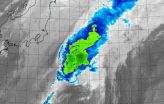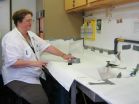(Press-News.org) NASA's Terra satellite passed over Tropical Storm Nuri on Nov. at captured an infrared picture of the storm. The storm looked more like a frontal system as it stretched from northeast to southwest.
The Moderate Resolution Imaging Spectroradiometer or MODIS instrument that flies aboard NASA's Terra satellite flew over Nuri on Nov. 6 at 1240 UTC (7:40 a.m. EST). The MODIS image showed some strong thunderstorms remaining in a small area around Nuri's center, but the storm appeared stretched out from northeast to southwest. Wind shear was affecting the storm, stretching it out.
The last bulletin on the storm was issued on Nov. 6 at 0300 UTC (Nov. 5 at 10 p.m. EST). At that time, the Joint Typhoon Warning Center (JTWC) noted that Nuri still had maximum sustained winds near 55 knots (63.2 mph/102 kph). It was located about 130 nautical miles (149 miles/240 km) west-northwest of Chichi-jima, near 29.2 north latitude and 141.0 east longitude. Nuri was moving to the northeast and over open waters of the western North Pacific.
In its final bulletin, JWTC noted that Nuri will become an extra-tropical storm before the end of the day on Nov. 6. Computer models indicate the system will be a strong extra-tropical low pressure area as it continues to move over open waters.
INFORMATION:
Rob Gutro
NASA's Goddard Space Flight Center
NASA sees Tropical Storm Nuri resemble a frontal system
2014-11-06
ELSE PRESS RELEASES FROM THIS DATE:
'Rewriting' the way to make natural drug compounds
2014-11-06
(SALT LAKE CITY)--One of the big hurdles in bringing drugs to market is the difficulty of producing large enough quantities of potential compounds to conduct clinical trials. This is particularly true with compounds made by organisms, which usually are produced in exceedingly small amounts and are difficult to synthesize in the laboratory.
Researchers from the University of Utah College of Pharmacy have made an important stride in addressing those problems. In a study in ACS Synthetic Biology, researchers led by Eric W. Schmidt, Ph.D., professor of medicinal chemistry, ...
NASA see birth of Tropical Cyclone 5B in Bay of Bengal
2014-11-06
The fifth tropical cyclone of the Northern Indian Ocean season formed in the Bay of Bengal as NASA's Terra satellite passed overhead and captured an image of the storm.
When Terra passed over Tropical Cyclone 5B on Nov. 6 at 05:05 UTC (12:05 a.m. EST), the MODIS instrument aboard took a visible image of the storm. The MODIS image showed a concentrated storm with strong thunderstorms circling tight around the center and in the northeastern quadrant.
By 1500 UTC (10 a.m. EST), Tropical Cyclone 5B was located near 13.4 north latitude and 87.9 east longitude. That's about ...
Study highlights prevalence of mistreatment between nursing home residents
2014-11-06
NEW YORK (November 6, 2014) -- Inappropriate, disruptive, or hostile behavior between nursing home residents is a sizable and growing problem, according to new research from Weill Cornell Medical College and Cornell University.
The study found that nearly one in five nursing home residents were involved in at least one negative and aggressive encounter with one or more fellow residents over the previous four weeks. These included acts of verbal or physical abuse, inappropriate sexual behavior, or invasion of privacy, among other incidents, known collectively as resident-to-resident ...
Denying problems when we don't like the political solutions
2014-11-06
DURHAM, N.C. -- There may be a scientific answer for why conservatives and liberals disagree so vehemently over the existence of issues like climate change and specific types of crime.
A new study from Duke University finds that people will evaluate scientific evidence based on whether they view its policy implications as politically desirable. If they don't, then they tend to deny the problem even exists.
"Logically, the proposed solution to a problem, such as an increase in government regulation or an extension of the free market, should not influence one's belief ...
Koala study reveals clues about origins of the human genome
2014-11-06
Eight percent of your genome derives from retroviruses that inserted themselves into human sex cells millions of years ago. Right now the koala retrovirus (KoRV) is invading koala genomes, a process that can help us understand our own viral lineage and make decisions about managing this vulnerable species.
In a recent study scientists from the University of Illinois discovered that 39 different KoRVs in a koala's genome were all endogenous, which means passed down to the koala from one parent or the other; one of the KoRVs was found in both parents.
Koalas are the ...
Retaining military veteran employees is all about the right fit
2014-11-06
It's a difficult career transition that can lead to more professional frustration and shorter tenure on the job for many of the newest generation of veterans employed with the U.S. Department of Veterans Affairs (VA) compared to their non-veteran co-workers.
New research from the University of Cincinnati is helping VA analyze the process of reintegrating veterans into civilian careers and evaluate methods for easing that transition. That's good news for all veterans as the nation prepares to observe Veterans Day on Nov. 11.
"This period of time within our labor force ...
Nutrients that feed red tide 'under the microscope' in major study
2014-11-06
The "food" sources that support Florida red tides are more diverse and complex than previously realized, according to five years' worth of research on red tide and nutrients published recently as an entire special edition of the scientific journal Harmful Algae.
The multi-partner project was funded by the National Oceanic and Atmospheric Administration's ECOHAB program* (described below) and included 14 research papers from seven institutions.
The research team studied four red tide blooms caused by the harmful algae species Karenia brevis in 2001, '07, '08 and '09, ...
Gut bacteria: How genes determine the fit of your jeans
2014-11-06
Our genetic makeup influences whether we are fat or thin by shaping which types of microbes thrive in our body, according to a Cornell-led study published today in the journal Cell.
By studying pairs of twins, researchers identified the Christensenellaceae bacterial family, which is highly heritable and more common in lean individuals. Moreover, a member of this class of bacteria, Christensenellaceae minuta, protected against weight gain when transplanted into mice.
The findings pave the way for personalized probiotic therapies that are optimized to reduce the risk ...
For tiger populations, a new threat
2014-11-06
Along with the pressures of habitat loss, poaching and depletion of prey species, a new threat to tiger populations in the wild has surfaced in the form of disease, specifically, canine distemper virus (CDV). According to a new study from the Wildlife Conservation Society (WCS) and its partners, CDV has the potential to be a significant driver in pushing the animals toward extinction.
While CDV has recently been shown to lead to the deaths of individual tigers, its long-term impacts on tiger populations had never before been studied.
The authors evaluated these impacts ...
Arm pain in young baseball players is common, preventable
2014-11-06
NEW YORK, NY (November 6, 2014) --The most in-dept survey of its kind found that arm pain is common among supposedly healthy young baseball players and nearly half have been encouraged to keep playing despite arm pain. The findings suggest that more detailed and individualized screening is needed to prevent overuse injury in young ballplayers. The study, led by Columbia University Medical Center (CUMC) researchers, was published this week in the online edition of the American Journal of Sports Medicine.
"Both nationally and internationally, we're witnessing a troubling ...





